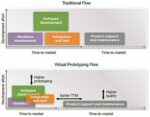Predictions in technology adoption often hinge on a delicate balance between technical feasibility and market dynamics. While business considerations play a pivotal role, the technical category reasons for the success or failure of a prediction are more tangible and often easier to identify—if scrutinized with care. However,… Read More
Tag: synopsys
A Deep Dive into SoC Performance Analysis: Optimizing SoC Design Performance Via Hardware-Assisted Verification Platforms
Part 2 of 2 – Performance Validation Across Hardware Blocks and Firmware in SoC Designs
Part 2 explores the performance validation process across hardware blocks and firmware in System-on-Chip (SoC) designs, emphasizing the critical role of Hardware-Assisted Verification (HAV) platforms. It outlines the validation workflow… Read More
A Deep Dive into SoC Performance Analysis: What, Why, and How
Part 1 of 2 – Essential Performance Metrics to Validate SoC Performance Analysis
Part 1 provides an overview of the key performance metrics across three foundational blocks of System-on-Chip (SoC) designs that are vital for success in the rapidly evolving semiconductor industry and presents a holistic approach to optimize… Read More
Enhancing System Reliability with Digital Twins and Silicon Lifecycle Management (SLM)
As industries become more reliant on advanced technologies, the importance of ensuring the reliability and longevity of critical systems grows. Failures in components, whether in autonomous vehicles, high performance computing (HPC), healthcare devices, or industrial automation, can have far-reaching consequences.… Read More
SystemReady Certified: Ensuring Effortless Out-of-the-Box Arm Processor Deployments
When contemplating the Lego-like hardware and software structure of a leading system-on-chip (SoC) design, a mathematically inclined mind might marvel at the tantalizing array of combinatorial possibilities among its hardware and software components. In contrast, the engineering team tasked with its validation may have… Read More
Synopsys-Ansys 2.5D/3D Multi-Die Design Update: Learning from the Early Adopters
The demand for high-performance computing (HPC), data centers, and AI-driven applications has fueled the rise of 2.5D and 3D multi-die designs, offering superior performance, power efficiency, and packaging density. However, these benefits come with myriads of challenges, such as multi-physics, which need to be addressed.… Read More
Synopsys and TSMC Pave the Path for Trillion-Transistor AI and Multi-Die Chip Design
Synopsys made significant announcements during the recent TSMC OIP Ecosystem Forum, showcasing a range of cutting-edge solutions designed to address the growing complexities in semiconductor design. With a strong emphasis on enabling next-generation chip architectures, Synopsys introduced both new technologies and … Read More
The Immensity of Software Development and the Challenges of Debugging Series (Part 2 of 4)
Part 2 of this 4-part series reviews the role of virtual prototypes as stand-alone tools and their use in hybrid emulation for early software validation, a practice known as the “shift-left” methodology. It assesses the differences among these approaches, focusing on their pros and cons.
Synopsys Powers World’s Fastest UCIe-Based Multi-Die Designs with New IP Operating at 40 Gbps
As the demand for higher performance computing solutions grows, so does the need for faster, more efficient data communication between components in complex multi-die system-on-chip (SoC) designs. In response to these needs, Synopsys has introduced the world’s fastest UCIe-based IP solution, capable of operating at a groundbreaking… Read More
Accellera and PSS 3.0 at #61DAC
Accellera invited me to attend their #61DAC panel discussion about the new Portable Stimulus Standard (PSS) v3.0, and the formal press release was also just announced. The big idea with PSS is to enable seamless reuse of stimulus across simulation, emulation and post-silicon debug and prototyping.
Tom Fitzpatrick from Siemens… Read More











